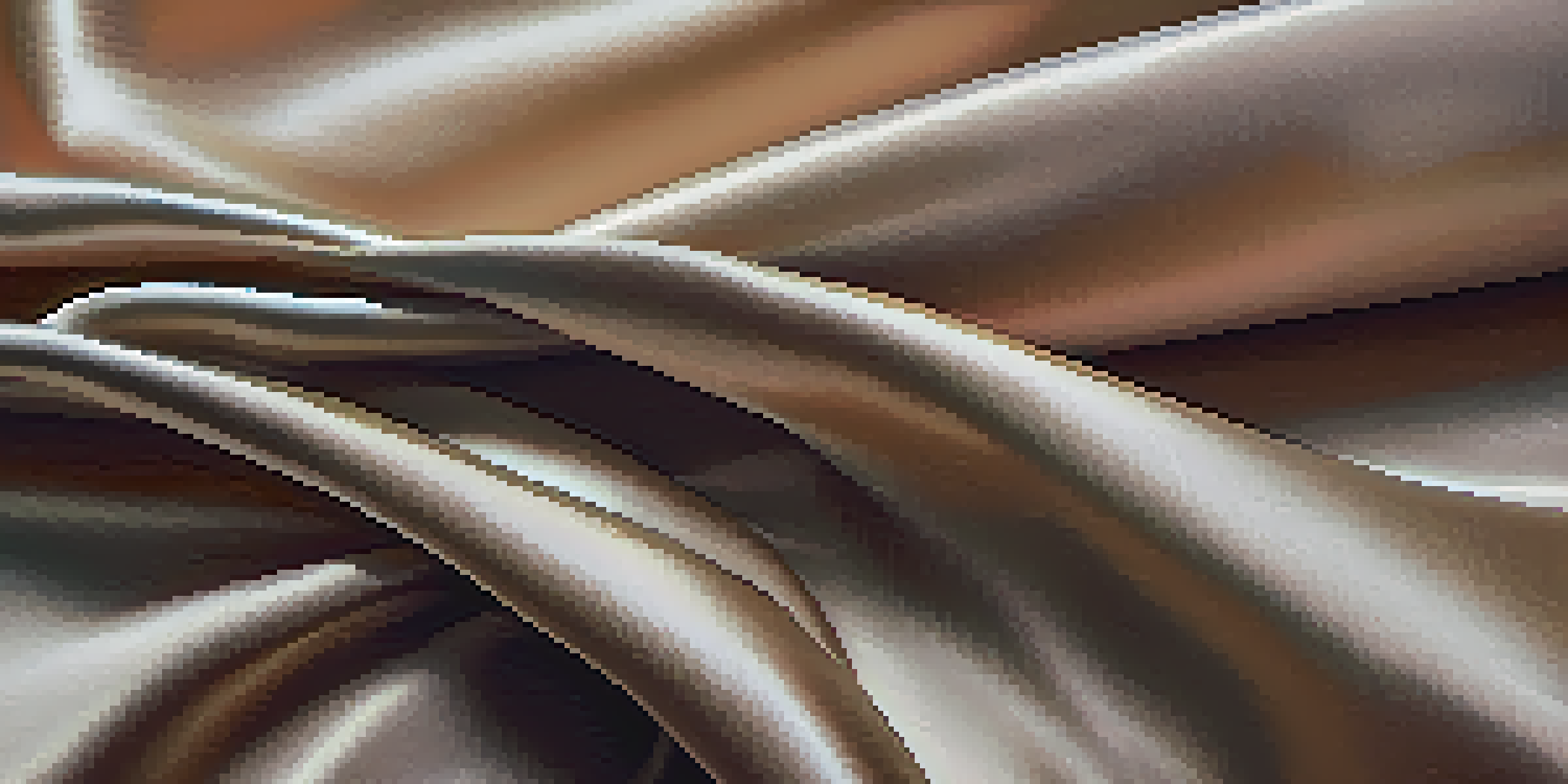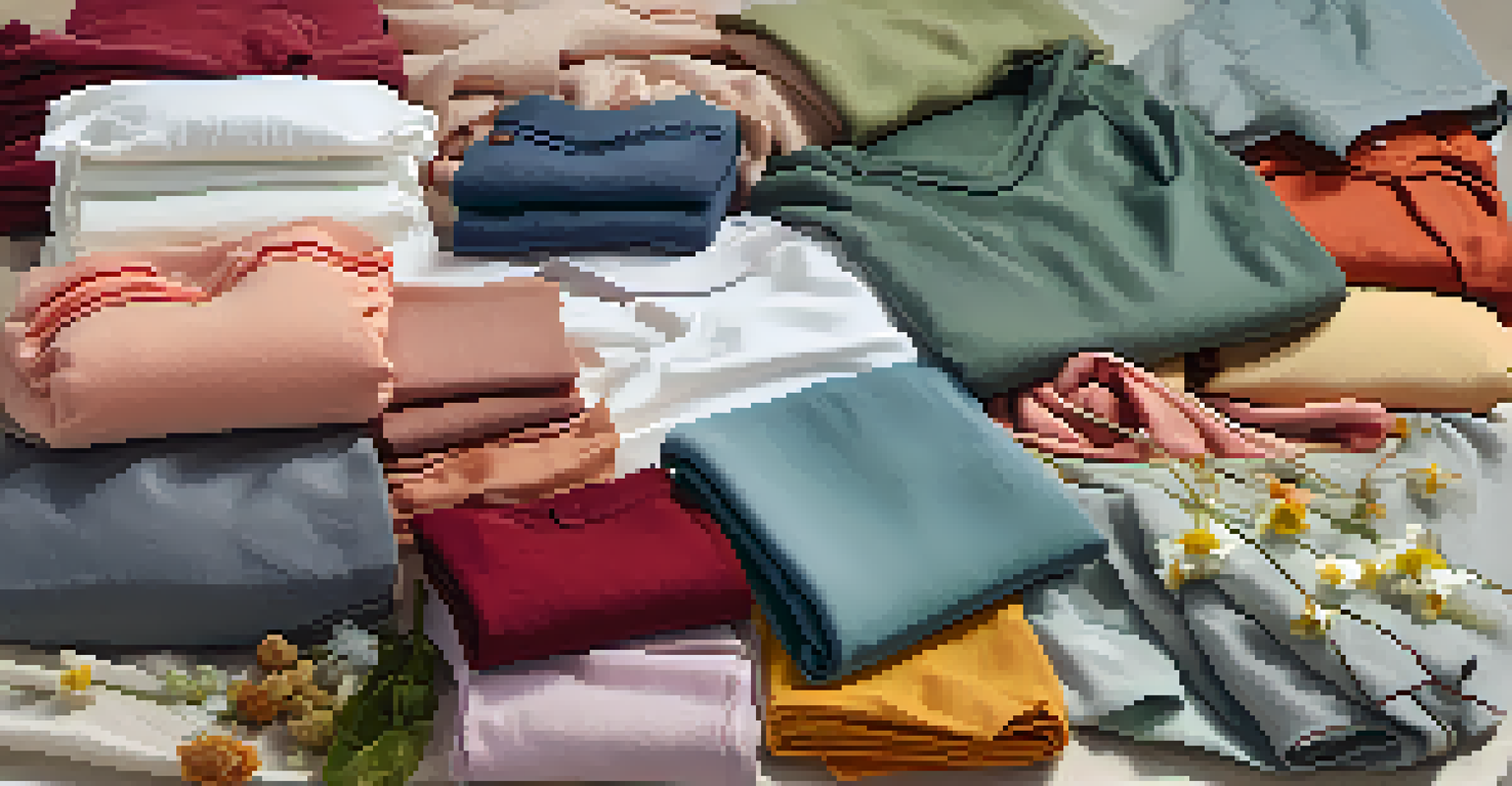The Benefits of Tencel Made from Eucalyptus Trees

What is Tencel and How is it Made from Eucalyptus Trees?
Tencel is a brand name for lyocell, a sustainable fabric derived from eucalyptus trees. The process begins with harvesting the trees, which are then turned into pulp. This pulp undergoes a solvent spinning process that transforms it into fibers, ready to be spun into fabric.
Sustainable fashion is not a trend; it's a movement toward a better world.
One of the key aspects of Tencel production is its eco-friendly approach. The solvents used in the process are non-toxic and are recycled, minimizing waste. This closed-loop process ensures that most of the chemicals are reused, making it a greener alternative compared to traditional fabric production methods.
Eucalyptus trees, the source of Tencel, grow quickly and require less water than cotton. This makes them an ideal choice for sustainable textile production, contributing to lower environmental impact. As a result, Tencel is often celebrated as a champion of eco-conscious fashion.
The Comfort and Breathability of Tencel Fabric
One of the standout features of Tencel is its incredible softness, which is often compared to silk. This luxurious feel makes it a popular choice for clothing, bed linens, and other textiles that come into close contact with the skin. Wearing Tencel is like wrapping yourself in a gentle hug.

In addition to its softness, Tencel is highly breathable. The fibers allow for excellent moisture absorption, which helps regulate body temperature. This means that Tencel clothing is comfortable to wear in both warm and cool conditions, making it versatile for year-round use.
Tencel: A Sustainable Fabric Choice
Tencel, made from eucalyptus trees, is produced through an eco-friendly process that minimizes waste and environmental impact.
People with sensitive skin will particularly appreciate Tencel’s hypoallergenic properties. The fabric is less likely to irritate the skin, making it a great option for those prone to allergies or reactions. This combination of comfort and breathability makes Tencel a favorite among many consumers.
Environmental Benefits of Tencel Production
Tencel’s production process is designed with sustainability at its core, which directly benefits the environment. The trees used are sourced from sustainably managed forests, ensuring that harvesting does not deplete natural resources. This commitment to sustainability helps protect biodiversity.
The greatest threat to our planet is the belief that someone else will save it.
Moreover, the closed-loop process of Tencel production drastically reduces water pollution. Traditional textile manufacturing often results in harmful chemicals entering waterways, but Tencel’s approach minimizes this risk. This makes Tencel a fabric that not only feels good but also does good for our planet.
Additionally, the use of eucalyptus trees means that Tencel requires significantly less water compared to cotton. This conservation of water is crucial in areas facing scarcity, making Tencel a more responsible choice for environmentally conscious consumers.
Durability and Maintenance of Tencel Fabrics
Tencel is not just about comfort and sustainability; it also boasts impressive durability. The fibers are strong and resistant to wrinkles, making Tencel garments easy to care for. This means less time spent on ironing and maintaining your wardrobe, which is a win for busy lifestyles.
When it comes to washing, Tencel fabrics are machine washable and maintain their quality over time. Unlike some delicate fabrics, Tencel withstands regular washing without losing its softness or strength. This durability ensures that your investment in Tencel items pays off in the long run.
Exceptional Comfort and Breathability
Tencel is renowned for its softness and breathability, making it an ideal fabric for those with sensitive skin and for year-round wear.
The ability to hold dye exceptionally well adds to Tencel's appeal, as it often results in vibrant colors that last. This quality enhances the aesthetic value of Tencel clothing, allowing fashion enthusiasts to enjoy beautiful, long-lasting pieces that stand out.
Tencel and Its Role in Sustainable Fashion
As consumers become more aware of their purchasing choices, Tencel has emerged as a leading fabric in the sustainable fashion movement. Many brands are incorporating Tencel into their collections to meet the demand for eco-friendly materials. This shift is encouraging a broader change in the fashion industry.
Fashion brands that utilize Tencel are not only providing stylish options but also making a statement about their commitment to sustainability. This alignment with eco-conscious values resonates with consumers who want to support brands that prioritize the planet. It's a win-win for both style and ethics.
Moreover, Tencel's versatility means it can be blended with other fibers, expanding its use in various clothing items. From casual wear to sophisticated attire, Tencel can adapt to different styles while maintaining its sustainable benefits, making it a favorite among designers and consumers alike.
The Future of Tencel and Sustainable Fabrics
Looking ahead, Tencel is poised to play a vital role in the evolution of sustainable textiles. As technology advances, the production processes may become even more efficient, further reducing environmental impacts. Innovations in fiber technology may also lead to new applications for Tencel in various industries.
The growing demand for transparency in fashion supply chains will likely propel Tencel to the forefront. Consumers are increasingly interested in where their clothes come from and how they’re made. Tencel’s commitment to sustainability positions it well for a future where eco-conscious choices are the norm.
Durability Meets Sustainable Fashion
Tencel is not only durable and easy to maintain but also plays a significant role in the sustainable fashion movement, appealing to eco-conscious consumers.
As more brands adopt Tencel and similar sustainable materials, we can expect to see a positive shift in the fashion landscape. This change not only benefits consumers but also contributes to a healthier planet. With Tencel leading the charge, the future of fashion looks brighter and more sustainable.
Conclusion: Embracing Tencel for a Sustainable Future
In summary, Tencel made from eucalyptus trees offers a multitude of benefits that appeal to both consumers and the environment. Its softness, breathability, and hypoallergenic properties make it a comfortable choice for a variety of textiles. Meanwhile, its sustainable production process plays a crucial role in protecting our planet.
As we navigate an increasingly eco-conscious world, embracing materials like Tencel can lead to more responsible consumption. Choosing Tencel is not just a fashion statement; it’s a commitment to supporting sustainable practices. By opting for Tencel products, you contribute to a future where fashion is aligned with environmental stewardship.

So next time you're shopping for clothing or home textiles, consider the impact of your choices. By choosing Tencel, you’re not only investing in quality and comfort but also championing a more sustainable future for fashion. Together, we can make a difference, one fabric at a time.